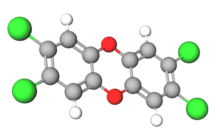2,3,7,8-Tetrachlorodibenzodioxin
TCDD is the most potent compound (congener) of its series (polychlorinated dibenzodioxins, known as PCDDs or simply dioxins) and became known as a contaminant in Agent Orange, an herbicide used in the Vietnam War.In 2000, the Expert Group of the World Health Organization considered developmental toxicity as the most pertinent risk of dioxins to human beings.In Vietnam and the United States, teratogenic or birth defects were observed in children of people who were exposed to Agent Orange or 2,4,5-T that contained TCDD as an impurity out of the production process.[3] After the Seveso accident, tooth development defects, changed sex ratio and decreased sperm quality have been noted.[3] Various developmental effects have been clearly shown after high mixed exposures to dioxins and dioxin-like compounds, the most dramatic in Yusho and Yu-chen catastrophes, in Japan and Taiwan, respectively.Very high doses may, in addition, cause cancer indirectly; one of the proposed mechanisms is oxidative stress and the subsequent oxygen damage to DNA.[3] According to a 2006 Molecular Nutrition & Food Research article, there were debates on whether TCDD was carcinogenic only at high doses which also cause toxic damage of tissues.[30] The Joint FAO/WHO Expert Committee on Food Additives (JECFA) derived in 2001 a provisional tolerable monthly intake (PTMI) of 70 pg TEQ/kg body weight.The U.S. Agency for Toxic Substance and Disease Registry has determined that levels higher than 1,000 ppt TEq in soil require intervention, including research, surveillance, health studies, community and physician education, and exposure investigation.[36] Seemingly similar species have varying sensitivities to acute effects: lethal dose for a guinea pig is about 1 μg/kg, but to a hamster it is more than 1,000 μg/kg.[36] Various hyperplastic (overgrowth) or atrophic (wasting away) responses are seen in different organs, thymus atrophy is very typical in several animal species.[40] The latter is important in that tooth deformities were also seen after the Seveso accident[41] and possibly after a long breast-feeding of babies in the 1970s and 1980s when the dioxin concentrations in Europe were about ten times higher than at present.Oxidation produces epoxide carcinogens that are rapidly detoxified by conjugation, but some molecules may escape to the nucleus of the cell and bind to DNA causing a mutation, resulting in cancer initiation.




Dioxins and dioxin-like compoundsPreferred IUPAC nameCAS NumberChEMBLChemSpiderECHA InfoCardPubChemCompTox DashboardSMILESChemical formulaMolar massDensityMelting pointSolubility in waterVapor pressureOccupational safety and healthpersistent organic pollutantGHS labellingPictogramsHazard statementsPrecautionary statementsNFPA 704Flash pointSafety data sheetstandard statepolychlorinated dibenzo-p-dioxinburningorganic synthesiscongenerdibenzodioxinsdioxinsAgent OrangeVietnam WarSeveso disasteraryl hydrocarbon (AH) receptortranscription factorexpressionenzymesenzyme inductioncarcinogenicpolycyclic hydrocarbonsbenzo(a)pyreneWorld Health Organizationteratogenic2,4,5-Tcausalmeta-analysisStillbirthscleft palateneural tube defectsspina bifidaSeveso accidentsex ratiomutagenicgenotoxicoxidative stressanti-estrogenicestrogenicInternational Agency for Research on Cancercarcinogengroup 1Molecular Nutrition & Food ResearchOperation Ranch HandInternational Journal of CancerDose-ResponseJoint FAO/WHO Expert Committee on Food AdditivesUnited States Environmental Protection AgencyAspen InstituteU.S. Agency for Toxic Substance and Disease Registryorgansanorexiathymusdevelopmental effectsteratogenicityhydronephrosisapoptosisoxidative enzymesepoxidechlorophenolschlorophenoxy acid herbicidescatalystsViktor YushchenkochloracneBoehringer IngelheimSevesoaccidental releasemultiple myelomamyeloid leukaemiaTimes BeachMissouriNEPACCOUnited StatesViennaamenorrheaUkraineTriangle of DeathToxic EquivalencyNational Institute for Occupational Safety and HealthBibcodeWayback Machinela Repubblicachemical warfareincapacitationriot controlBlood agentsCyanogenCyanogen bromideCyanogen chlorideHydrogen cyanideArsineCacodyl cyanideCacodyl oxideHydrogen sulfidePhosphineCarbon monoxidePhosphorus trifluorideMethyl cyanoformateIron pentacarbonylNickel tetracarbonylGlycolonitrileLactonitrileAcetone cyanohydrinStibineChloral cyanohydrinBlister agentsArsenicals